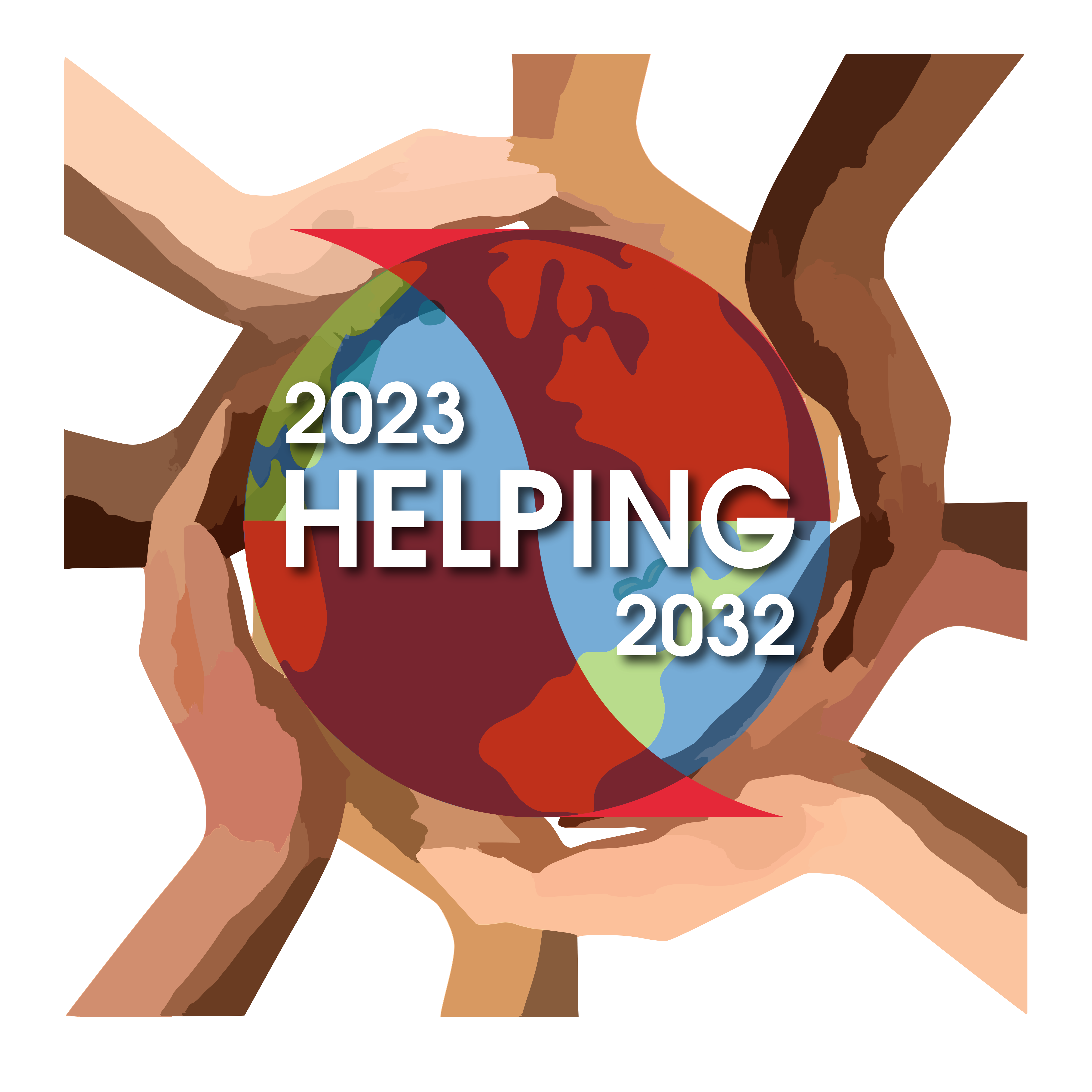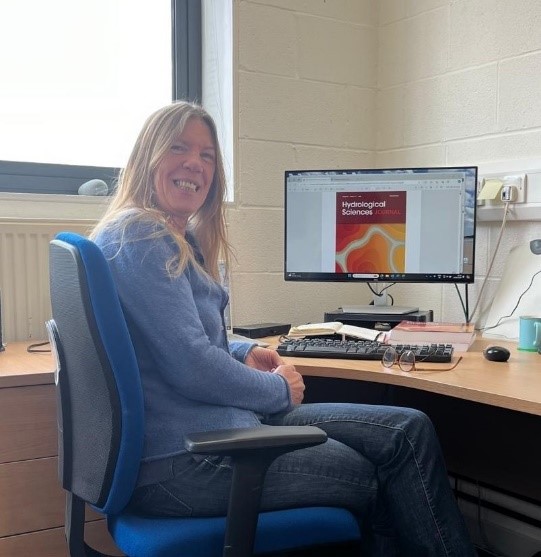Hydrological Sciences Journal DigestLatest articles & Journal updates | |
|---|
| | |
|---|
The latest news from HSJ
Welcome to HSJ Digest, our bi-monthly synopsis of the latest news from Hydrological Sciences Journal. In this issue, in addition to our regular features, we reveal the winner of this year’s prestigious Tison Award. Read too about our key community paper setting out visions for the HELPING decade. And in our regular profile of HSJ people, meet Lottie Rundall, Editorial & Production Manager.

Tison Award – winner announced!
We are delighted to announce the winner of the prestigious Tison Award, given annually by IAHS for excellence in research by young hydrologists.

The winner of the 2024 Tison Award is Martin Addi, who, with co-authors Yeboah Gyasi-Agyei, Emmanuel Obuobie and Leonard Kofitse Amekudzi, wrote "Evaluation of imputation techniques for infilling missing daily rainfall records on river basins in Ghana". The paper is free to view.
The IAHS Tison Award, established in 1982, is granted for an outstanding paper published by IAHS in the two years prior to the nomination deadline. The awardee is presented with a $1000 USD prize and a one-year subscription to HSJ, co-sponsored by IAHS and Taylor & Francis, the publisher of Hydrological Sciences Journal. The award will be presented to Martin Addi during the 2025 IAHS Scientific Assembly in Roorkee, India, in October 2025.
Read more about this and other IAHS and HSJ awards (including the Associate Editor, Reviewer and Frances Watkins Memorial awards).
Ushering in the HELPING decade
The new scientific decade (2023–2032) of IAHS endorses mutual learning and co-creation to progress towards UN sustainable development goals, seeking viable solutions to water-related problems. The community paper The IAHS Science for Solutions decade, with Hydrology Engaging Local People IN one Global world (HELPING) brings together a distinguished team of over 100 authors, led by Berit Arheimer, to set out the decade’s vision of solving problems by engaging with other disciplines and local stakeholders. Read this Open Access article in full in HSJ volume 69, issue 11.

| Great news for those interested in LaTeX submissions
Keep on reading in this issue of the Digest...
Openly in HSJ 
Key Open Access papers from the last three issues
Join the IAHS Science for Solutions decade, HELPING, to address global water crises. Arheimer et al. maintain that by collaborating with local communities and other disciplines, we can develop sustainable holistic solutions and contribute to a more equitable and resilient future worldwide.
Stable isotopes of water offer a valuable tool for understanding evaporative conditions in high-mountain tropical lakes. Lyon et al. reveal insights into seasonal variations and the role of lake size in influencing isotopic composition and evaporation rates.
Accurate water supply forecasting depends on reliable hydrological models. Shin et al. analyse the large basin runoff model (LBRM) and the weather research and forecasting hydrological modelling extension package, and highlight the importance of assessing both surface and subsurface fluxes for improved operational water management in the Great Lakes region.
Keith Beven considers The Science of Waters (1653) by Père Jean François: the 17th-century Jesuit priest's largely overlooked book on water balance offers new insights into the early history of hydrology.
Despite increased micro-irrigation adoption, overall irrigation use has declined in Maharashtra, India, due to the unintended consequences of intervention programmes. This study by Adla and co. proposes a more holistic approach to the adoption of sustainable irrigation technology. | |
|---|
HSJ Vol. 69
Issue 10
Co-editors’ choice - Featured article
Low-flow period seasonality, trends, and climate linkages across the United States
Caelan Simeone et al.
Low-flow timing, magnitude and duration are critical for water resource management and aquatic ecosystems functioning. The study analysed low-flow period properties across the conterminous United States for a seventy-year period and observed important spatiotemporal variations, with trends linked to climate factors. Low-flow periods are becoming longer in some regions but shorter in others, influenced by temperature and precipitation patterns.
Research articles
Assessment of hydropedological characteristics at medium-sized landslide sites in Manafwa catchment, Mount Elgon, Uganda
Moses Kutosi et al.
Extending the historical in situ gauge network over Indian river reaches utilizing the Surface Water and Ocean Topography (SWOT) mission
Manu K. Soman and J. Indu
Assessment and mapping of potential sites for small-scale hydropower in Gidabo River catchment
Eyoel Yigeltu Aybehon, W.M. Tefera and Beyene Akirso
Spatio-temporal clustering of extreme floods in Great Britain
Giuseppe Formetta, Cecilia Svensson and Elizabeth Stewart
Non-stationary models for hydrological extremes in the mountain rivers of the Argentinean Central Andes
Carolina Lauro et al.
Spatial variability of rainfall: deciphering flood characteristics and model precision
Indhu Dasari and Vamsi Krishna Vema
Spatiotemporal evolution of water resource sustainability in Shaanxi (China) from 2010 to 2020 based on an adapted water resources ecological footprint model
Xiaofei Li et al.
Pre-processing satellite rainfall products improves hydrological simulations with machine learning
Tayeb Boulmaiz et al.
Analysis of hydrological responses using semi-distributed conceptual models in a mountainous catchment in the Hindu Kush Himalayan region
Mani Kanta Malla and Dhyan Singh Arya
Experimental study of hydrodynamics of groundwater flow in karst aquifers
Amin Hassan et al.
Technical note
Laboratory observations for examining estimates of soil dry surface layer thickness with parsimonious models
Cara Mathers et al. | HSJ Vol. 69
Issue 11
Co-editors’ choice - Featured article
Assessing uncertainties of a remote sensing-based discharge reflectance model for applications to large rivers of the Congo Basin
Djamel Kechnit et al.
Remote-sensing techniques are shown to accurately predict river discharge in the Congo Basin, providing essential data for water resource management in this challenging region.
Opinion
The IAHS Science for Solutions decade, with Hydrology Engaging Local People IN one Global world (HELPING)
Berit Arheimer et al.
Research articles
A new method for predicting precipitation δ18O distribution based on deep learning and spatio-temporal clustering
Yang Li et al.
Effects of digital elevation model resolution on rain-on-grid simulations: a case study in a Slovenian watershed
Marcos Julien Alexopoulos et al.
Novel formulation of Slichter’s model for permeability determination in unconsolidated materials: a critical review through field data
Kosta Urumović et al.
Ensemble learning of decomposition-based machine learning models for multistep-ahead daily streamflow forecasting in northwest China
Haijiao Yu et al.
Stable water isotopic composition and evaporation to inflow ratios for high-mountain tropical Ecuadorian lakes
Steve W. Lyon et al.
Technical note
Evaluating surface and subsurface fluxes in hydrological models to advance basin-scale operational water supply forecasting
Satbyeol Shin et al.
Reply
Reply to discussion of “An assessment of small Island hydrological research activity conducted in the Oceania Region
Chris Leong et al.
LaTeX submissions
HSJ is pleased to announce that we are trialling LaTeX manuscript submissions to the Journal. Authors can choose from either Word or LaTeX templates for their submissions here. | HSJ Vol. 69
Issue 12
Co-editors’ choice - Featured article
Spatiotemporal variability in surface velocity of large tributary-bearing glaciers of the Indian Himalayas inferred from SAR polarimetry
Shubham Bhattacharjee and Rahul Dev Garg
A new method using radar data has revealed detailed glacier movement patterns in the Indian Himalayas, providing crucial insights into climate change and glacier stability.
Special issue: History of hydrology
On “The Science of Waters” by Père Jean François from 1653
Keith Beven
Research articles
Assessment of spatial variability of precipitation in Krishna River Basin using a metric based on apportionment entropy
Salvadi Chetan Kumar, N. Siva Sai Syam and Maheswaran Rathinasamy
Steering agricultural interventions towards sustained irrigation adoption by farmers: socio-psychological analysis of irrigation practices in Maharashtra, India
Soham Adla et al.
Assessment of future drought sensitivity shift associated with crop yield loss risk in the Anthropocene
Muhammad Waseem et al.
Thermal structure variations and influence factors in a subtropical reservoir, China: explanations from multiple research methods
Wenyan Zhao et al.
Spatiotemporal forecasting of water change trends in Urmia Lake through to 2030, using STC-based models
Hamed Ahmadi et al.
Modification of Green-Ampt model based on multi-stage characteristics of soil water infiltration
Fusheng Zha et al.
Technical note
Evaluation of input variable selection methods in artificial neural networks for estimating missing daily precipitation
Mehran Ghodrati and Alireza B. Dariane
Special Issues
Submissions are open here for our new Latin America Special Issue:
Advances in hydrological science in Latin America. Meanwhile, there is still time to submit to Twenty-first century hydrological challenges and opportunities in Africa and to History of hydrology. | |
|---|
|
|---|
| Meet the Editor
Lottie Rundall, Editorial & Production Manager
Lottie Rundall works with Kate Hill in the Editorial Office of HSJ, and together they handle manuscripts from submission through to production (the latter stages in collaboration with our publisher, Taylor & Francis). Lottie’s publishing career began in 1990 at a small academic press in Oxford, and since then she has worked as an editor, writer and translator on numerous academic and educational resources, as well as illustrated non-fiction books in areas as diverse as science, travel and art history; she has for many years also had a parallel career in education, teaching Spanish and French and supporting children with learning difficulties.

“If joining HSJ two months before the first Covid lockdown was unlucky timing, stepping into the shoes of Frances Watkins, who had so capably run the Journal for nearly 30 years, was no less a challenge! Nearly five years on, at the heart of a small and close-knit team in the Editorial Office, I enjoy the endless variety of this job. I love working alongside our superb Co-editors, whose editorial judgement and commitment are without compare, together with our wider Editorial Board and IAHS – a true ‘family’, all motivated by the common goal of sharing knowledge. Conferences and Editorial Retreats have provided wonderful opportunities to meet in person these exceptional scientists whose vital research we are privileged to publish.” | |
|---|
Join IAHS & HSJ online
As the official Journal of IAHS, HSJ is freely available online to IAHS members from financially disadvantaged countries. Membership of IAHS is free to all. Sign up for HSJ online ‘new content alerts’ from our publishers Taylor & Francis. | Digital Water Globe
Share your research using the IAHS Digital Water Globe (DWG) – an innovative tool specially designed for, and by, IAHS members. Here you can give visibility to (un)published results, research sites and find peers for collaborating around the world. | HSJ Editorial Board
We are indebted to the relentless hard work of the Journal’s five Co-editors and c. 60 Associate Editors. Meet them here. | |
|---|
|
|